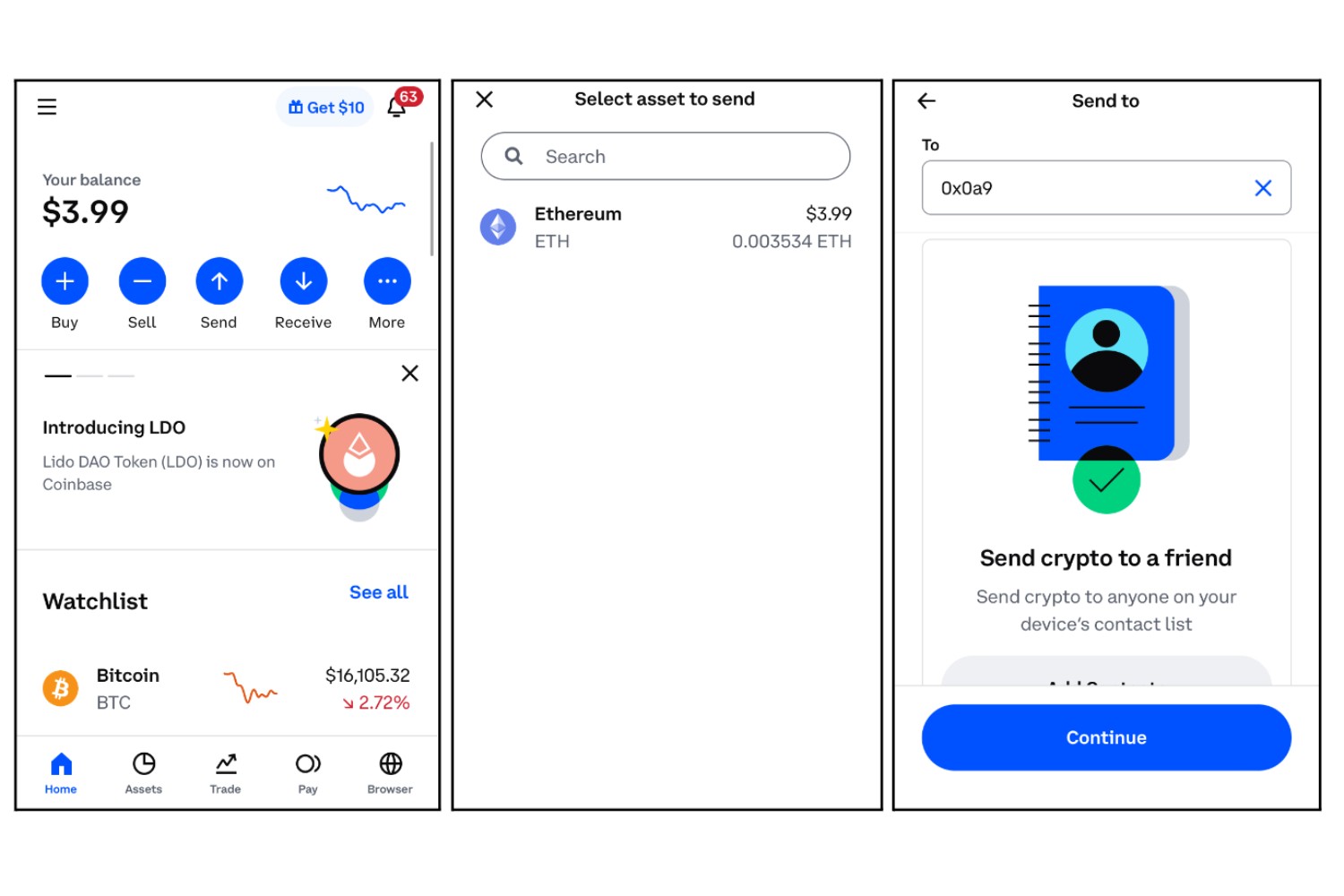What is Ethereum?
Ethereum is a decentralized, open-source blockchain platform that enables the creation and execution of smart contracts. It was envisioned by Vitalik Buterin in 2013 and launched in 2015. Unlike Bitcoin, which is primarily a digital currency, Ethereum is designed to be a platform for decentralized applications (DApps) and the building of new blockchain-based projects.
At its core, Ethereum allows developers to create and deploy smart contracts, which are self-executing agreements with predefined rules. These contracts are powered by Ether (ETH), the native cryptocurrency of the Ethereum network. Ether can be used both as a digital currency to facilitate transactions and as “gas” to pay for the computational resources required to execute smart contracts.
What sets Ethereum apart is its ability to support complex, programmable applications and the development of decentralized autonomous organizations (DAOs). It offers a Turing-complete programming language called Solidity, which allows developers to write smart contracts that can handle complex logic and interact with each other.
Ethereum also introduced the concept of decentralized finance (DeFi) to the blockchain world. DeFi refers to the use of blockchain and cryptocurrencies to recreate traditional financial systems, such as lending, borrowing, and trading, without the need for intermediaries like banks or brokers. This has opened up new possibilities for financial inclusion and innovation, as anyone with an internet connection can participate in DeFi protocols on the Ethereum network.
The Ethereum network operates using a consensus algorithm called Proof-of-Stake (PoS), which is undergoing a transition from the current Proof-of-Work (PoW) algorithm. This transition to Ethereum 2.0, also known as ETH2 or Serenity, aims to address scalability and energy consumption issues by allowing users to stake their Ether and participate in the network’s security and consensus.
In summary, Ethereum is a groundbreaking blockchain platform that enables the creation of smart contracts and DApps. It has revolutionized the world of decentralized finance and is undergoing a significant upgrade to improve scalability and energy efficiency through the transition to a Proof-of-Stake consensus mechanism.
Understanding Staking
Staking is a process that allows users to participate in the validation and security of a blockchain network by holding and “staking” their cryptocurrency tokens. It is an alternative consensus mechanism to traditional Proof-of-Work (PoW) systems like Bitcoin mining. Staking involves users locking up a certain amount of their cryptocurrency holdings in a wallet to support network operations.
When it comes to Ethereum, staking plays a crucial role in the transition to Ethereum 2.0 and the adoption of the Proof-of-Stake (PoS) consensus mechanism. In a PoS system, validators are chosen to create new blocks and validate transactions based on the amount of cryptocurrency they hold and are willing to lock up as collateral in their wallets. The more tokens a user stakes, the higher their chances of being selected as a validator and earning rewards.
By staking their Ethereum tokens, users actively contribute to the security and efficiency of the network. Validators are incentivized to act honestly and follow the rules of the network, as any malicious behavior could result in the slashing of their staked tokens. Slashing refers to the reduction or confiscation of tokens for violating network rules or attempting to attack the system.
Staking also serves as a mechanism for users to earn passive income by participating in network maintenance. Validators are rewarded with additional cryptocurrency for their efforts, typically in the form of newly minted tokens or transaction fees collected from the network. The reward rate varies depending on the network’s parameters and the number of tokens staked.
It’s important to note that staked tokens are typically locked up for a certain period during the staking process. This means that users may not be able to freely transfer or sell their tokens until the lock-up period ends or they decide to unstake. However, this lock-up period helps ensure the stability and security of the network by discouraging malicious activity or quick profit-taking.
Overall, staking is a fundamental concept in decentralized blockchain networks like Ethereum. It allows users to actively participate in network security, earn rewards for their contributions, and helps facilitate the transition to a more scalable and energy-efficient consensus mechanism. Staking Ethereum is not only a way to earn passive income, but also a way to support the growth and development of the Ethereum ecosystem.
How Does Staking Ethereum Work on Coinbase?
Staking Ethereum on Coinbase is a straightforward and user-friendly process. Coinbase, one of the leading cryptocurrency exchanges, allows its users to stake their Ethereum and earn rewards directly on the platform. Here’s a breakdown of how staking Ethereum works on Coinbase:
- Eligibility: To stake Ethereum on Coinbase, you need to be a user of Coinbase and meet certain eligibility requirements. These requirements may include geographic restrictions or account verification processes. Ensure that you meet all the necessary criteria before proceeding.
- Staking Pool: Coinbase operates a staking pool, which means that users’ staked Ethereum is pooled together, and Coinbase acts as the validator on behalf of its users. By participating in the staking pool, users can benefit from earning rewards without having to run their own validator nodes.
- Staking Rewards: When you stake your Ethereum on Coinbase, you become eligible to earn staking rewards. The rewards are distributed based on the amount of Ethereum you have staked and the duration of your stake. The specific rewards distribution and rates may vary, and it’s important to understand the terms and conditions set by Coinbase.
- Stake Duration: Staking Ethereum on Coinbase typically requires a minimum stake duration, during which your Ethereum will be locked up and unavailable for withdrawal or trading. The stake duration may vary depending on the specific staking service and the network parameters. Make sure you are comfortable with the lock-up period before staking your Ethereum.
- Earnings and Withdrawals: As a participant in Coinbase’s staking pool, you will earn staking rewards in the form of additional Ethereum. These earnings are usually credited to your Coinbase account periodically. Once the earnings are credited, you can choose to leave them in your account and continue staking, or you can withdraw them to an external wallet or trade them on the exchange.
It’s important to note that staking Ethereum on Coinbase may have certain risks and trade-offs. While you can enjoy the convenience and ease of staking, you are entrusting Coinbase as the validator. This means that you give up some control and rely on Coinbase’s operation and security measures. It’s essential to research and understand Coinbase’s reputation and the measures they have in place to protect users’ funds.
In summary, staking Ethereum on Coinbase allows users to participate in Ethereum’s Proof-of-Stake (PoS) consensus mechanism and earn staking rewards. By joining Coinbase’s staking pool, users can stake their Ethereum without the need to run their own validator nodes. However, it’s crucial to understand the eligibility requirements, stake duration, and potential risks associated with staking Ethereum on Coinbase before making a decision.
Requirements for Staking Ethereum on Coinbase
Before you can start staking Ethereum on Coinbase, there are several requirements you need to fulfill. These requirements ensure that you meet the necessary criteria and have the appropriate setup to participate in staking. Here are the requirements for staking Ethereum on Coinbase:
- Valid Coinbase Account: The first requirement is to have a valid Coinbase account. If you don’t already have one, you’ll need to sign up for an account and complete the verification process. Coinbase operates in various countries, so ensure that your country and region are supported by Coinbase.
- Ethereum Holdings: To stake Ethereum on Coinbase, you’ll need to have a sufficient amount of Ethereum in your Coinbase wallet. The specific minimum requirements may vary depending on the staking service’s terms and conditions. Ensure that you have enough Ethereum to meet the minimum stake requirement.
- Eligibility Criteria: Coinbase may have additional eligibility criteria for users to stake Ethereum. This can include factors such as geographic restrictions or account verification processes. These criteria are in place to ensure compliance with regulatory requirements and to maintain the security of their staking service.
- Supported Ethereum Network: Staking on Coinbase is specific to the Ethereum network. Ensure that the Ethereum network is supported by Coinbase for staking. Different networks may have different staking services and requirements, so make sure you are staking Ethereum and not another cryptocurrency.
- Understanding the Terms and Risks: Before staking Ethereum on Coinbase, it’s crucial to understand the terms and risks associated with the staking service. Read and familiarize yourself with Coinbase’s staking terms, including details about stake duration, rewards distribution, potential penalties, and other important considerations.
Meeting these requirements is essential to ensure a smooth and successful staking experience on Coinbase. It’s important to note that these requirements may evolve or change over time, depending on Coinbase’s policies and the evolving landscape of staking services.
By fulfilling the requirements, you can take advantage of Coinbase’s staking platform and participate in Ethereum’s Proof-of-Stake (PoS) consensus mechanism. Staking allows you to earn rewards while actively contributing to the security and efficiency of the Ethereum network.
Ensure that you have a valid Coinbase account, sufficient Ethereum holdings, meet the eligibility criteria, and understand the terms and risks before initiating the staking process. Once all the requirements are met, you can start staking Ethereum on Coinbase and enjoy the benefits of participating in the network’s security and earning staking rewards.
Step-by-Step Guide to Staking Ethereum on Coinbase
If you’re ready to stake Ethereum on Coinbase, here is a step-by-step guide to help you navigate the process:
- Create or Verify Your Coinbase Account: If you don’t already have a Coinbase account, sign up for one on the Coinbase website or mobile app. Follow the necessary steps to create your account and complete the verification process, if required.
- Add Ethereum to Your Coinbase Wallet: Once your Coinbase account is set up and verified, deposit Ethereum into your Coinbase wallet. You can do this by selecting the “Accounts” tab on the Coinbase platform, choosing your Ethereum wallet, and clicking on the “Receive” or “Deposit” button. Follow the prompts to complete the deposit process and ensure that the Ethereum is successfully added to your wallet.
- Access the Staking Platform: In the Coinbase platform, navigate to the section or tab that is dedicated to staking. Look for options like “Staking” or “Earn Rewards” to access the staking platform. Coinbase may also provide educational resources and information about staking Ethereum.
- Select Ethereum Staking: Within the staking platform, locate the Ethereum staking option and click on it to initiate the staking process. This will provide you with the necessary details, eligibility requirements, and terms and conditions specific to staking Ethereum on Coinbase.
- Review the Terms and Conditions: Before proceeding further, take the time to thoroughly review the terms and conditions of staking Ethereum on Coinbase. Understand the stake duration, rewards distribution, potential penalties, and any other important considerations. Ensure that you are comfortable with the terms before proceeding.
- Confirm Your Staking Amount: Once you have reviewed the terms and conditions, select the amount of Ethereum you wish to stake. This can be done by inputting the desired amount or selecting from the available options provided by Coinbase. Ensure that you have enough Ethereum in your Coinbase wallet to meet the minimum stake requirement.
- Initiate the Staking Process: After confirming your staking amount, proceed to initiate the staking process. This may involve clicking on a “Stake” or similar button, confirming your decision, and accepting any additional prompts or agreements presented by Coinbase. Double-check all the information before proceeding.
- Review and Track Your Staking: Once your Ethereum is staked, Coinbase will provide you with information and updates regarding your staking status. You can monitor your staking activity, track your rewards, and view any relevant statistics or data provided by Coinbase. Keep an eye on your staking performance and any changes or updates provided by Coinbase.
- Manage Your Staked Ethereum: While your Ethereum is staked, it will be locked up for a specific period. During this time, you may not be able to freely transfer or trade your staked Ethereum. However, Coinbase may provide options to unstake your Ethereum or withdraw your staking rewards if you choose to do so. Familiarize yourself with the unstaking process and any applicable timelines or requirements.
By following this step-by-step guide, you can successfully stake Ethereum on Coinbase and start earning staking rewards. Remember to double-check all the information, understand the terms and conditions, and monitor your staking activity to make the most of your staking experience on Coinbase.
Benefits and Risks of Staking Ethereum on Coinbase
Staking Ethereum on Coinbase offers several benefits, but it’s essential to consider the associated risks. Here are the key benefits and risks of staking Ethereum on Coinbase:
Benefits:
- Earn Staking Rewards: By staking Ethereum on Coinbase, you have the opportunity to earn staking rewards. These rewards are typically distributed in the form of additional Ethereum tokens. The exact reward rate may vary, but staking can provide a passive income stream for participating in network validation.
- Convenience and User-Friendliness: Coinbase’s staking platform offers convenience and user-friendliness. You can stake your Ethereum directly on Coinbase without the need to set up your own validator node or manage complex technical processes. Coinbase handles the validation on your behalf, making it accessible for users without extensive technical knowledge.
- Security and Reliability: Coinbase is a reputable and trusted cryptocurrency exchange. By staking Ethereum on Coinbase, you leverage their security measures and infrastructure, reducing the risks associated with running your own validator node. Coinbase’s reputation and track record provide assurance to users that their staked Ethereum is in safe hands.
- Passive Income Generation: Staking Ethereum on Coinbase allows you to generate passive income without actively trading or investing in other assets. As long as you meet the staking requirements and maintain your stake, you can earn rewards continuously. This can be especially appealing for long-term Ethereum holders looking to make their assets work for them.
Risks:
- Lack of Control: When staking Ethereum on Coinbase, you give up some control over the validation process. Coinbase acts as the validator on your behalf, which means you rely on their operation and security measures. If Coinbase experiences any technical issues or suffers from security breaches, it may impact your staking performance and rewards.
- Lock-Up Period and Liquidity: Staking Ethereum on Coinbase typically involves a lock-up period during which your staked Ethereum is inaccessible. This lack of liquidity may limit your ability to freely transfer or trade your Ethereum during this period. Consider your short-term liquidity needs and the impact of the lock-up period before staking.
- Platform Risks and Changes: As with any service provider, there are inherent risks associated with using a staking platform like Coinbase. Changes in Coinbase’s policies, staking terms, or the overall staking infrastructure may affect your staking experience. Stay informed about any updates or changes made by Coinbase and ensure they align with your expectations and long-term goals.
- Crypto Market Volatility: Staking Ethereum on Coinbase does not shield you from the volatility of the cryptocurrency market. The value of Ethereum can fluctuate significantly, potentially impacting your overall staked value. Be prepared for potential market volatility and understand that your staked Ethereum is still subject to market dynamics.
Understanding the benefits and risks of staking Ethereum on Coinbase is crucial when considering whether to participate. Evaluate these factors based on your risk appetite, investment goals, and overall understanding of staking services to make an informed decision.
Frequently Asked Questions (FAQs) about Staking Ethereum on Coinbase
Here are some commonly asked questions about staking Ethereum on Coinbase:
1. Can I stake any amount of Ethereum on Coinbase?
Yes, you can stake any amount of Ethereum on Coinbase, as long as it meets the minimum stake requirement set by Coinbase. However, keep in mind that the amount you stake may affect the rewards you earn. Typically, the more Ethereum you stake, the higher your chances of earning staking rewards.
2. Can I unstake my Ethereum before the lock-up period is over?
The ability to unstake Ethereum before the lock-up period varies depending on the staking service and the specific terms set by Coinbase. Some platforms may offer the option to unstake early, but it may come with penalties or restrictions. Review the terms and conditions provided by Coinbase to understand the unstaking process and any applicable timelines or requirements.
3. Do I maintain ownership of my staked Ethereum on Coinbase?
Yes, you maintain ownership of your staked Ethereum on Coinbase. Staking does not involve selling or transferring ownership of your Ethereum tokens. By staking, you are essentially locking up your Ethereum as collateral to support the network’s security and consensus. Once the lock-up period ends or you decide to unstake, you regain full control and ownership of your Ethereum.
4. Are my staking rewards automatically reinvested?
On Coinbase, staking rewards are typically automatically credited to your account. However, the decision to reinvest or compound your staking rewards is up to you. You can choose to leave the rewards in your account and continue staking, or you can withdraw them or use them for other purposes, such as trading or investing in other cryptocurrencies.
5. Can I stake Ethereum on Coinbase from any country?
Staking services on Coinbase may have geographic restrictions depending on regulatory requirements and the specific staking service being offered. Ensure that your country and region are supported by Coinbase for staking Ethereum. If there are any restrictions, Coinbase will provide information on eligible regions during the staking process.
6. Will staking Ethereum on Coinbase affect my ability to trade or sell my Ethereum?
Staking Ethereum on Coinbase typically involves a lock-up period during which your staked Ethereum is unavailable for trading or selling. Once the lock-up period ends or you decide to unstake, you regain the ability to freely trade or sell your Ethereum. However, it’s important to note that market conditions and liquidity may still impact the ability to buy or sell Ethereum at any given time.
These FAQs provide some general information about staking Ethereum on Coinbase. However, it’s important to refer to Coinbase’s official resources and documentation for the most accurate and up-to-date information regarding their specific staking services and terms.
Conclusion
Staking Ethereum on Coinbase offers an accessible and convenient way to participate in the network’s Proof-of-Stake (PoS) consensus mechanism and earn staking rewards. By staking your Ethereum on Coinbase, you contribute to the security and efficiency of the Ethereum network while potentially earning passive income.
Throughout this guide, we have explored what Ethereum is, how staking works, and the process of staking Ethereum on Coinbase. We discussed the requirements, benefits, and risks associated with staking on this platform.
When staking Ethereum on Coinbase, it’s important to assess your risk tolerance, evaluate the lock-up period, and consider the potential impact of market volatility. Additionally, stay informed about any changes or updates made by Coinbase regarding their staking services.
Staking Ethereum on Coinbase can be an attractive option for those looking for a user-friendly staking experience. It provides an opportunity to earn staking rewards without the complexities of running your own validator nodes. However, it’s essential to do thorough research, understand the terms and conditions, and consider your own goals and circumstances before making a decision.
Remember, investing in cryptocurrency inherently carries risks, and there are no guarantees when it comes to returns or market conditions. It’s always advisable to seek professional financial advice and understand the potential implications before engaging in any investment activities.
With the information provided in this guide, you are now equipped with the knowledge to make an informed decision about staking Ethereum on Coinbase. Whether you choose to stake Ethereum on Coinbase or explore other staking options, remember to stay informed, stay secure, and always prioritize your own financial well-being.

























